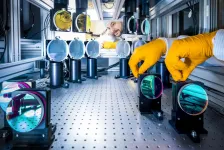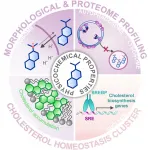Scientists reverse age-related memory loss in mice
2021-07-22
(Press-News.org) Scientists at Cambridge and Leeds have successfully reversed age-related memory loss in mice and say their discovery could lead to the development of treatments to prevent memory loss in people as they age.
In a study published today in Molecular Psychiatry, the team show that changes in the extracellular matrix of the brain - 'scaffolding' around nerve cells - lead to loss of memory with ageing, but that it is possible to reverse these using genetic treatments.
Recent evidence has emerged of the role of perineuronal nets (PNNs) in neuroplasticity - the ability of the brain to learn and adapt - and to make memories. PNNs are cartilage-like structures that mostly surround inhibitory neurons in the brain. Their main function is to control the level of plasticity in the brain. They appear at around five years old in humans, and turn off the period of enhanced plasticity during which the connections in the brain are optimised. Then, plasticity is partially turned off, making the brain more efficient but less plastic.
PNNs contain compounds known as chondroitin sulphates. Some of these, such as chondroitin 4-sulphate, inhibit the action of the networks, inhibiting neuroplasticity; others, such as chondroitin 6-sulphate, promote neuroplasticity. As we age, the balance of these compounds changes, and as levels of chondroitin 6-sulphate decrease, so our ability to learn and form new memories changes, leading to age-related memory decline.
Researchers at the University of Cambridge and University of Leeds investigated whether manipulating the chondroitin sulphate composition of the PNNs might restore neuroplasticity and alleviate age-related memory deficits.
To do this, the team looked at 20-month old mice - considered very old - and using a suite of tests showed that the mice exhibited deficits in their memory compared to six-month old mice.
For example, one test involved seeing whether mice recognised an object. The mouse was placed at the start of a Y-shaped maze and left to explore two identical objects at the end of the two arms. After a short while, the mouse was once again placed in the maze, but this time one arm contained a new object, while the other contained a copy of the repeated object. The researchers measured the amount of the time the mouse spent exploring each object to see whether it had remembered the object from the previous task. The older mice were much less likely to remember the object.
The team treated the ageing mice using a 'viral vector', a virus capable of reconstituting the amount of 6-sulphate chondroitin sulphates to the PNNs and found that this completely restored memory in the older mice, to a level similar to that seen in the younger mice.
Dr Jessica Kwok from the School of Biomedical Sciences at the University of Leeds said: "We saw remarkable results when we treated the ageing mice with this treatment. The memory and ability to learn were restored to levels they would not have seen since they were much younger."
To explore the role of chondroitin 6-sulphate in memory loss, the researchers bred mice that had been genetically-manipulated such that they were only able to produce low levels of the compound to mimic the changes of ageing. Even at 11 weeks, these mice showed signs of premature memory loss. However, increasing levels of chondroitin 6-sulphate using the viral vector restored their memory and plasticity to levels similar to healthy mice.
Professor James Fawcett from the John van Geest Centre for Brain Repair at the University of Cambridge said: "What is exciting about this is that although our study was only in mice, the same mechanism should operate in humans - the molecules and structures in the human brain are the same as those in rodents. This suggests that it may be possible to prevent humans from developing memory loss in old age."
The team have already identified a potential drug, licensed for human use, that can be taken by mouth and inhibits the formation of PNNs. When this compound is given to mice and rats it can restore memory in ageing and also improves recovery in spinal cord injury. The researchers are investigating whether it might help alleviate memory loss in animal models of Alzheimer's disease.
The approach taken by Professor Fawcett's team - using viral vectors to deliver the treatment - is increasingly being used to treat human neurological conditions. A second team at the Centre recently published research showing their use for repairing damage caused by glaucoma and dementia.
INFORMATION:
The study was funded by Alzheimer's Research UK, the Medical Research Council, European Research Council and the Czech Science Foundation.
ELSE PRESS RELEASES FROM THIS DATE:
2021-07-22
In the depths of space, there are celestial bodies where extreme conditions prevail: Rapidly rotating neutron stars generate super-strong magnetic fields. And black holes, with their enormous gravitational pull, can cause huge, energetic jets of matter to shoot out into space. An international physics team with the participation of the Helmholtz-Zentrum Dresden-Rossendorf (HZDR) has now proposed a new concept that could allow some of these extreme processes to be studied in the laboratory in the future: A special setup of two high-intensity laser beams could create conditions similar to those found near neutron stars. In ...
2021-07-22
Over the last few decades, neurodegenerative diseases became one of the top 10 global causes of death. Researchers worldwide are making a strong effort to understand neurodegenerative diseases pathogenesis, which is essential to develop efficient treatments against these incurable diseases. However, our knowledge about the basic molecular mechanisms underlying the pathogenesis of neurodegenerative diseases is still lacking. A team of researchers found out the implication of lysosomes in the spread of Parkinson's disease.
The accumulation of misfolded protein aggregates in affected brain regions is a common hallmark shared by several neurodegenerative diseases (NDs). Mounting evidence in cellular and in animal models highlights the capability ...
2021-07-22
Artificial intelligence tools and deep learning models are a powerful tool in cancer treatment. They can be used to analyze digital images of tumor biopsy samples, helping physicians quickly classify the type of cancer, predict prognosis and guide a course of treatment for the patient. However, unless these algorithms are properly calibrated, they can sometimes make inaccurate or biased predictions.
A new study led by researchers from the University of Chicago shows that deep learning models trained on large sets of cancer genetic and tissue histology data can easily identify the institution that submitted the images. The models, which use machine learning methods to "teach" themselves how to recognize certain cancer signatures, ...
2021-07-22
Replication of SARS-CoV-2, the virus responsible for COVID-19, depends on a series of interactions between viral proteins and different cellular partners such as nucleic acids (DNA or RNA). Characterizing these interactions is crucial to elucidate the process of viral replication and identify new drugs for treating COVID-19.
An interdisciplinary consortium of scientists from the Institut Pasteur, the Ecole Polytechnique, the Institut Curie, Inserm, the CNRS and the universities of Paris, Paris-Saclay, Bordeaux and Toulouse have demonstrated a specific interaction between a domain of a SARS-CoV-2 protein (Nsp3) and ...
2021-07-22
When Alexander Flemming discovered a mould on a culture plate overgrown with bacteria in 1928, he did not expect to find one of the most widely used active substances: penicillin. Accidental discoveries and the identification of active ingredients from traditional remedies, such as the morphine of the opium poppy, have shaped the discovery of new medicines for a long time.
Modern drug discovery - from chance to system
Meanwhile, major developments in chemistry and molecular biology have been made that enable a systematic and targeted search for potential active substances in modern drug discovery. First, advances in the field of organic and ...
2021-07-22
TROY, N.Y. -- An innovative testing platform that more closely mimics what cancer encounters in the body may allow for more precise, personalized therapies by enabling the rapid study of multiple therapeutic combinations against tumor cells. The platform, which uses a three-dimensional environment to more closely mirror a tumor microenvironment, is demonstrated in research published in Communications Biology.
"This whole platform really gives us a way to optimize personalized immunotherapy on a rapid, high throughput scale," said Jonathan Dordick, Institute Professor of chemical and biological engineering and member of the Center for Biotechnology and Interdisciplinary Studies (CBIS) at Rensselaer Polytechnic Institute, ...
2021-07-22
It's a favourite first-order for the day, but while a quick coffee may perk us up, new research from the University of South Australia shows that too much could be dragging us down, especially when it comes to brain health.
In the largest study of its kind, researchers have found that high coffee consumption is associated with smaller total brain volumes and an increased risk of dementia.
Conducted at UniSA's Australian Centre for Precision Health at SAHMRI and a team of international researchers*, the study assessed the effects of coffee on the brain among 17,702 UK Biobank participants (aged 37-73), finding that those who drank more than six cups of coffee a day had a 53 per cent increased risk of dementia.
Lead researcher and UniSA PhD candidate, ...
2021-07-22
Silicon, a semi-metal, bonds in its natural form with four other elements and its three-dimensional structure takes the form of a tetrahedron. For a long time, it seemed impossible to achieve the synthesis and characterisation of a two-dimensional equivalent - geometrically speaking, a square. Now scientists from the field of Inorganic Chemistry at Heidelberg University have succeeded in producing a crystalline complex with such a configuration. PD Dr Lutz Greb from the Institute of Inorganic Chemistry underlines that it has surprising physical and chemical properties and, in the field of molecular chemistry, will open up new approaches to using the second most abundant element in the Earth's crust for catalysis and materials research.
As a classical ...
2021-07-22
The touchscreen technology used in billions of smartphones and tablets could also be used as a powerful sensor, without the need for any modifications.
Researchers from the University of Cambridge have demonstrated how a typical touchscreen could be used to identify common ionic contaminants in soil or drinking water by dropping liquid samples on the screen, the first time this has been achieved. The sensitivity of the touchscreen sensor is comparable to typical lab-based equipment, which would make it useful in low-resource settings.
The researchers say their proof of concept could one day be expanded for a wide range of sensing applications, including for biosensing or medical diagnostics, right from the phone in your pocket. The results are reported ...
2021-07-22
Many applications, from fiber-optic telecommunications to biomedical imaging processes require substances that emit light in the near-infrared range (NIR). A research team in Switzerland has now developed the first chromium complex that emits light in the coveted, longer wavelength NIR-II range. In the journal Angewandte Chemie, the team has introduced the underlying concept: a drastic change in the electronic structure of the chromium caused by the specially tailored ligands that envelop it.
Many materials that emit NIR light are based on expensive or rare metal complexes. Cheaper alternatives that emit in the NIR-I range between 700 and 950 nm have been developed but NIR-II-emitting complexes of non-precious metals remain extremely rare. Luminescence in the NIR-II range (1000 to 1700 ...
LAST 30 PRESS RELEASES:
[Press-News.org] Scientists reverse age-related memory loss in mice

